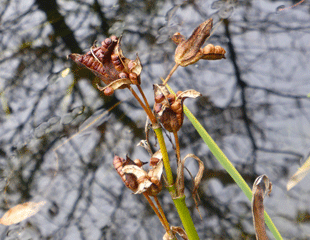
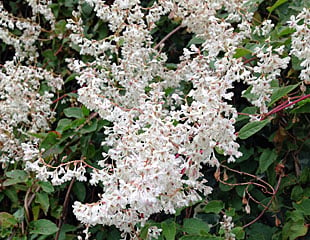
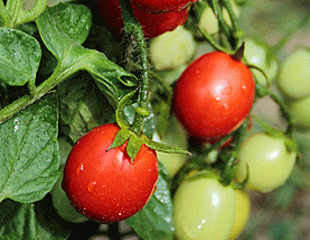
What to do in the garden in September
September marks the start of autumn, and we can see the garden beginning to slow down. Some herbaceous perennials and annuals have finished for the summer, others, such as roses and sweet peas, may keep on flowering. Exactly what is flowering and when depends on the sort of spring and summer we have enjoyed, but there is plenty of late colour in the garden.
Looking for some inspiring September colour? Plants and Shrubs Flowering in September.
September Gardening Checklist –
Trim Lavender
Plan Spring Bedding
Last Chance to Prune Wisteria
Perennials: What to prune now
How to Overwinter Tender Plants
Order Spring Bulbs
Deadhead to prolong flowering
Collect seed for next year's flowers
Store onions and Garlic in a dry place
Harvest the main crop Potatoes
Keep watering and feeding the tomatoes
Make a late sowing of herbs
Time to trim Lavender
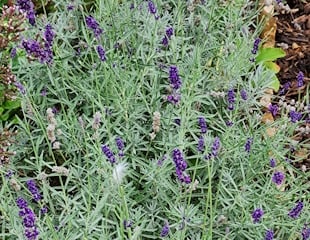
Standard gardening advice is to prune Lavender when it has finished flowering, which is often around late August, depending on the season.
I don't rush to prune Lavender because sometimes you can get a second flowering. And not just a few stems but a good showing, as in the image on the left, which was taken in late September.
Check out the pros and cons of when to prune lavender, late summer or early spring.
Whenever you prune, avoid cutting into the woody stems.
Plan Spring Bedding

Wallflowers are a lovely spring bedding plant with wonderful scent, amongst the sweetest scented of our garden plants. At this time of year you can order bare rooted plants, much cheaper than pot ready and easier than seed. Give the plants a good soak and plant in a reasonably sunny position, and by spring, they will be blooming away.
I like to team them up with Tulips and a great combination is from Suttons of Harlequin Mixed Wallflowers, and Tulip Fire Wings for a really bold spring display. (affiliate link)
Last Chance to Summer Prune Wisteria
Late August and early September are the last opportunities to summer-prune Wisteria. Regular, twice-yearly pruning is essential to keep wisteria in check and flowering.
In late summer, tie in the essential growth required for the framework and prune out excessive growth, or long whippy shoots which are not needed or too long. The long shoots can be cut back to within half a dozen buds from the main framework.
The video shows step by step how to do the summer prune.
Perennials : what to cut back and what to leave?
During September, many perennials will look tired, with browning leaves. Later, as frosts strike, some of the herbaceous perennials will collapse into brown heaps, but some garden plants keep their shape.
The question is what to cut back and what to leave?
Some plants look good as they fade, such as sedum, where the flower heads hold their own for weeks and look good with a dusting of frost. Others, such as Hosta look a mess.
There is no hard and fast rule about what to do with herbaceous and perennial plants once summer is over.
Some gardeners cut everything back, clearing out the borders, and others leave plants uncut to encourage wildlife and cultivate a less formal look. There is also a halfway house; cut back plants that look a mess, such as Hosta, Crocosmia, and Delphinium, leaving in place those which still add to the border, at least for a while, which also spreads the work in the garden over the winter months. As with many aspects of gardening, there is no right or wrong, it's down to preference.
I cut back some, not least because the summer weeds sheltering under the plants, so cutting back reveals them. I try to get the borders weed-free over the autumn and winter and then mulch, ready for next year; at least that's the plan.
How to Overwinter and Protect tender plants
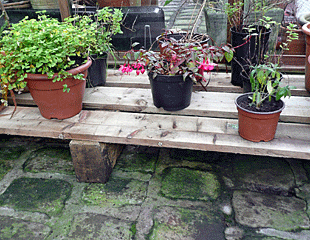
By late September, the risk of frost is not far away, and it is a good time to consider which of the tender plants are worth saving to overwinter in a frost free place. For example, Pelargoniums survive well in a conservatory or a sunny porch, or garden lean to, and look lovely for months as they continue to flower. Fuchsias, and Pelargoniums can be put under glass, others such as Petunias, Marguerite's, Diascias, Osteopermums are ready for taking cuttings-click here for more information.
If you are overwintering plants in a greenhouse, raise the plants off the ground because the base can be very cold, especially when sitting on concrete slabs. Raising the plants off the ground is warmer, and it allows air to circulate. Damp, stagnant air aids disease, especially grey mould, which can so often be a problem when overwintering plants. If you can overwinter the tender plants, it saves money for next year, and you start the spring with a mature plant, which should flower well.
If you don't have a conservatory or greenhouse in which to overwinter plants, you can put them in a lean-to. This video explains some useful steps to ensure the survival of tender plants overwinter.
The most important points are to remove most of the foliage, keep the plant dry, and allow plenty of air circulation. The video details this further. Damp, stagnant air is the main cause of Botrytis, also known as grey mould, which attacks overwintering plants.
Time to think about Spring bulbs
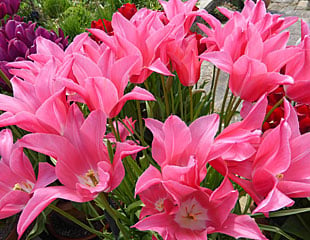
Autumn is time for planting spring bulbs.
It's best to plant daffodils during September, whereas Tulips should be left until October/ November. The correct planting depth is crucial to ensure the bulbs flower in the spring; if too shallow, they will not flower. An easy rule of thumb is to plant the bulb 3x or preferably 4x times it's own depth. The planting depth is more important than the time of planting. If you miss the window, you can still plant most bulbs, except snowdrops, as late as December or early January, particularly late flowering varieties.
For inspirations and images of spring bulbs, look at Pinterest Spring bulbs
Money Saving tip
Money saving tip: It is not necessary when planting new spring bulbs in containers to use fresh compost. You can reuse compost from any end of season containers being cleared out. A bulb is a complete power pack and has everything within the bulb to flower next year and needs no additional nutrients. Read more about using old compost and saving money.
Deadhead to prolong flowering
It is still worth dead-heading perennials and annuals, especially the late flowering ones. Depending on the summer, even annuals such as sweet peas may still flower and, to keep them going, continue to deadhead unless you want to collect the seed.
The late flowering perennials, such as Dahlias, will benefit greatly from continuous deadheading.
Seed collection
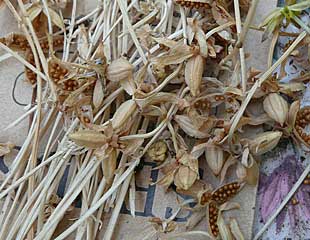
Late summer/early autumn is a good time to collect seed if you want to use it next year. Collect seed heads, carefully shaking or scraping out the small seeds, and store in a packet in a dry place - a sealed tin is useful.
Moisture is the enemy when you are saving and storing seeds. Seeds need to be stored in a dry and cool place, such as in the garage or in a fridge. I sometimes add grains of rice to absorb any lingering moisture, or those little packs of silica gel which come with some goods (because they absorb water.)
A good starting place if you've not collected seeds before are Viola, Rocket, Nasturtiums, Calendula, Cerinthe major, cornflower, and the bean family, all of which are easy to collect and germinate. Given the cost of seeds, it is worth a try.
September in the Veg plot
How to Store onions and garlic
The veg plot is full of crops ready for harvesting, and September is the time to pick, freeze and store. All the beans are ready and creating gluts, Sweet corn has ripened, onions and garlic are now fat bulbs. Ideas on what to do with a glut of Green Beans.
Onions will be ready either at the end of August or early September, depending on the weather. To harvest, bend over the top growth (if this hasn't already happened naturally) and harvest during a dry spell and ease the bulbs out of the earth. Traditionally, onions were dried by resting on soil during a sunny spell. With our variable weather it's difficult to find a dry spell to rest the onions outside.
An alternative if the weather is poor is to lay the onions out in the greenhouse - drop the foliage down between the slats and rest the onions on the slats, which is an ideal way to dry them out, see the images below. You can also dry onions in a shed by placing them in netting or even on newspaper in a conservatory. The onion bulbs must be completely dry before storing, and the same applies to garlic.
Garlic is similar, wait till the top growth dries and turns brown, usually in August/Sept. Store in a dry and light spot in the warmth rather than a cold area.
If you want to make onion or garlic strings when you harvest the bulb, keep as much of the top growth as possible to make into a plait. If there is not enough top growth, work in some raffia to help make a plait.
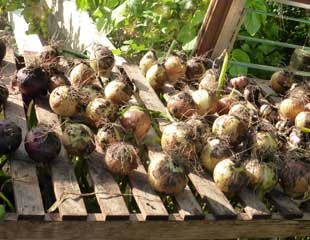
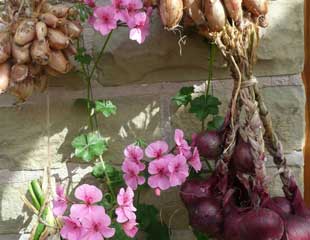
The images show garlic and onions drying in a greenhouse, when summers are wet, this is the most practical way of drying onions and garlic ready for storage over winter. The right image onions strings storing overwinter in a conservatory. Onions and garlic easy crops to grow and for ideas for next year's crop advice on growing garlic and onions.
Harvest main crop Potatoes
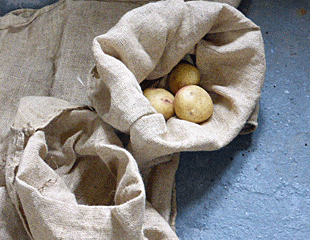
This month, you can harvest main crop potatoes and must store them in a dry and dark place. The Hessian sacks sold by garden centres and on-line shops are ideal for storing potatoes. Potatoes can go green very quickly when exposed to light, even if left in a greenhouse for just 24 hours they will turn green.
To prevent this, you need to exclude light and move then to a dark place very soon after harvesting. Potatoes also need to be dry; if they are wet when you dig them up, put them somewhere to dry off, but quickly as soon as they are dry, take out of the light and put them in sacks/somewhere dry and dark. The Hessian sacks are good because they are a natural fibre, but you can use other mediums just to avoid plastic or polythene, which will tend to trap moisture.
This time of year, it's hard to avoid a glut of something, ideas for what to do with a glut of beans. All the beans family, French, broad, runners, and peas home freeze well.
Courgettes are more difficult as they don't really freeze very well, and I make a mental note, each year, to grow fewer plants next year as there always seem to be too many.
Tomato Care
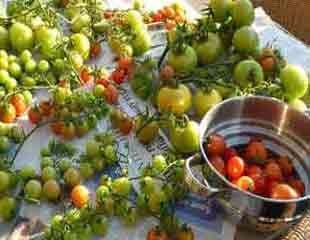
Tomatoes continue to need a lot of attention, and it is important to water either daily or every other day, depending on conditions, and feed regularly at least twice weekly. As the month moves on towards October and the plants are naturally slowing down, reduce the amount of watering and feeding. When to do this will depend on where in the country the Tomatoes are being grown; the growing season is longer in the South of the country. If the plants are still growing, they will continue to produce leaves, and it is important to continue to thin these down to encourage the fruit to ripen. As the fruits ripen, the vines will need extra support and ties. Using soft raffia is good as it reduces damage to the tomato stems.
Sometimes it's difficult to get tomatoes to ripen late in the season Click here for a foolproof way to ripen tomatoes.
And sometimes we have a glut of tomatoes. Click here for recipe ideas for a glut of tomatoes.
For the best advice about growing tomatoes, including how to grow them from seed, which are the best types of tomatoes to grow, the right way to water tomatoes and much more, check out the Sunday Gardener's handy book " Success with Tomatoes" A concise, informative and practical guide containing all you need to know to ensure a tasty crop.
Last sowings of Herbs and Salad
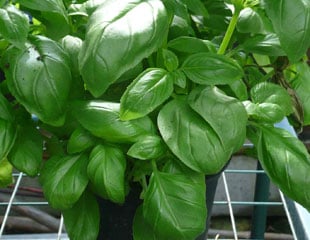
In many parts of the country, this is the last chance to sow rocket and salad and if the weather is cool, cover with a cloche to encourage germination and growth.
This is a good time to replenish dried herbs, which lose their pungency after a period of storage. Ideal herbs for drying are Oregano, Sage, Mint and also, Thyme and Rosemary, although as hardy perennials, we can pick them all year round.
Tender Herbs such as Basil, Coriander, and dill it is best to pot up later in the month and bring in under glass ahead of any autumn chill.
